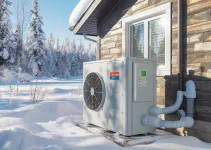In an era where energy costs and environmental concerns shape home and business decisions, heat pumps have emerged as one of the most promising sustainable heating solutions. They combine impressive efficiency with versatility, helping property owners reduce their carbon footprint and save money over time. This article explores the full spectrum of heat pump benefits, from energy performance to cost savings, and examines why they are central to the future of energy efficient heating.
Why Heat Pumps Matter in 2025
The global heat pump market reached $88.4 billion in 2024 and is projected to grow to $93.2 billion in 2025, with further expansion to $124.5 billion by 2029. The International Energy Agency (IEA) reports that in 2024, heat pump sales outpaced gas boilers by 30% — a significant milestone. Modern systems can deliver 3–4 times more energy than they consume, making them 300–400% efficient compared to the roughly 90% efficiency of traditional boilers.
Heat pumps are a key technology to decarbonize heating. They can slash emissions, improve energy efficiency, and reduce reliance on fossil fuels, especially in colder climates where they were once considered impractical.
— Dr. Fatih Birol
High Energy Efficiency and Performance
Heat pumps work by transferring heat instead of generating it, which dramatically reduces energy consumption. This principle allows them to reach efficiencies well beyond conventional systems. For example, a high-performance air source heat pump can provide three units of heat for every unit of electricity consumed.
| Heating System | Typical Efficiency | Energy Source |
|---|---|---|
| Gas Boiler | ~90% | Natural Gas |
| Oil Boiler | ~85% | Heating Oil |
| Air Source Heat Pump | 300–400% | Electricity |
| Ground Source Heat Pump | 350–450% | Electricity |
As shown above, the efficiency gap is significant, and it translates into both lower utility bills and reduced environmental impact.
Environmental Benefits and Carbon Reduction
Switching from fossil fuel heating to a heat pump can cut CO₂ emissions by up to 50%, depending on the electricity mix. In areas with high renewable energy penetration, emissions can approach net-zero. This makes heat pumps a cornerstone technology for meeting climate targets.
Many systems are now compatible with solar PV arrays, enabling homeowners to generate clean electricity to power their heating. In commercial settings, integrating heat pumps into renewable-powered microgrids is becoming a viable strategy.
Versatility for Heating and Cooling
One of the most attractive heat pump benefits is their dual functionality: they provide both heating in winter and cooling in summer. This versatility means property owners can replace separate HVAC systems with a single, integrated solution.
Advances in cold-climate models allow heat pumps to operate efficiently even at temperatures as low as -25°C, which was once considered impractical. This opens up adoption in Nordic countries, Canada, and the northern United States.
For more technical insights into specific models, see our detailed guide on Air Source Heat Pumps.
Cost Savings Over Time
While the upfront cost of a heat pump can be higher than traditional systems, government incentives and the long-term savings on energy bills often offset this investment. For example:
| System Type | Upfront Cost (USD) | Annual Running Cost | Estimated Payback |
|---|---|---|---|
| Gas Boiler | $4,000 | $1,200 | N/A |
| Air Source Heat Pump | $8,000 | $600 | 6–8 years |
| Ground Source Heat Pump | $18,000 | $500 | 8–10 years |
Government programs such as the US Inflation Reduction Act offer tax credits up to $2,000 for installations, while the UK Boiler Upgrade Scheme provides grants of £7,500.
Improvements in affordability, efficiency, and performance have made heat pumps viable even in older buildings and cold regions, expanding their potential market.
— BCC Research Analysts
Case Studies: Real-World Success Stories
Consider a mid-sized office building in New York that replaced its aging oil boiler with an air source heat pump. The project qualified for state incentives, reducing upfront costs by 30%. Within the first year, the building’s energy consumption dropped by 40%, and emissions fell significantly.
In residential settings, homeowners in Massachusetts have reported year-round comfort and lower bills after switching to ground source heat pumps, even during harsh winters. For a step-by-step understanding of setting up your own system, see Heat Pump Installation: A Step-by-Step Homeowner Guide.
Integration with Renewable Energy
Heat pumps align perfectly with renewable energy strategies. When powered by solar or wind, they can deliver truly sustainable heating and cooling. Hybrid systems that combine heat pumps with backup gas can ensure reliability in extreme conditions while keeping emissions low.
Future Trends and Innovations
The next generation of heat pumps will feature:
- Smart thermostat integration for optimized energy use
- Low-GWP refrigerants to minimize environmental impact
- Enhanced performance in cold climates
Policy support is also expanding. The EU Green Deal and similar programs worldwide are accelerating adoption, with projections showing installations could triple by 2035 under current climate commitments.
Implementation Considerations
Before investing in a heat pump, assess your building’s insulation, local climate, and available incentives. Consult with certified installers who can recommend the right type — air source, ground source, or hybrid — for your needs.
Ground source systems, for instance, require more upfront planning but deliver higher efficiency. Learn more about them in our Beginner’s Guide to Ground Source Heat Pumps & Geothermal Energy.
Conclusion
Heat pumps offer unmatched efficiency, versatility, and environmental benefits, making them a leading choice for sustainable heating solutions. With government incentives, advancing technology, and growing market adoption, they are poised to replace fossil fuel systems across the globe.
For homeowners and businesses, the decision to switch is both a practical and strategic move toward energy independence and climate responsibility. Whether you choose an air source or ground source system, the benefits are clear: lower bills, reduced emissions, and year-round comfort.
Now is the time to explore your options, take advantage of incentives, and position your property at the forefront of sustainable heating innovation.



No Responses